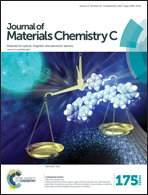Increased thermal stabilization of polymer photovoltaic cells with oligomeric PCBM†
Abstract
The first oligomerisation of phenyl-C61-butyric acid methyl ester (PCBM) using a facile atom transfer radical addition polymerization (ATRAP) and its exploitation for organic photovoltaic devices is described. Oligo{(phenyl-C61-butyric acid methyl ester)-alt-[1,4-bis(bromomethyl)-2,5-bis(octyloxy)benzene]} (OPCBMMB) shows opto-electronic properties equivalent to those of PCBM but has a higher glass transition temperature. When mixed with various band gap semiconducting polymers, OPCBMMB delivers performances similar to PCBM but with an enhanced stabilization of the bulk heterojunction in photovoltaic devices on plastic substrates under thermal stress, regardless of the degree of crystallinity of the polymer and without changing opto-electronic properties.



 Please wait while we load your content...
Please wait while we load your content...